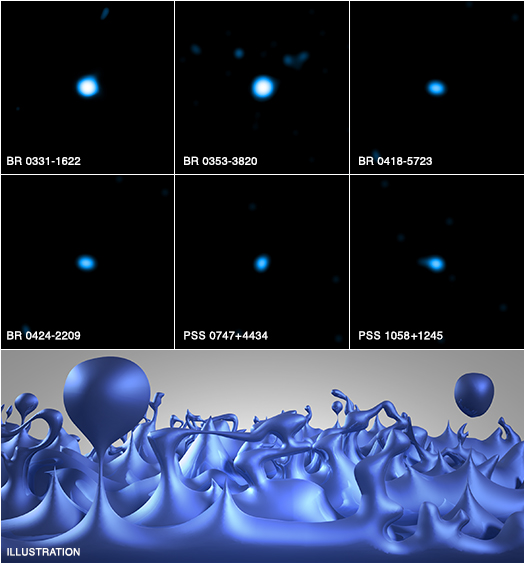For Release: May 28, 2015
CXC
A team of scientists has used X-ray and gamma-ray observations of some of the most distant objects in the Universe to better understand the nature of space and time. Their results set limits on the quantum nature, or “foaminess” of space-time at extremely tiny scales.
This study combines data from NASA’s Chandra X-ray Observatory and Fermi Gamma-ray Space Telescope along with ground-based gamma-ray observations from the Very Energetic Radiation Imaging Telescope Array (VERITAS).
At the smallest scales of distance and duration that we can measure, space-time – that is, the three dimensions of space plus time – appears to be smooth and structureless. However, certain aspects of quantum mechanics, the highly successful theory scientists have developed to explain the physics of atoms and subatomic particles, predict that space-time would not be smooth. Rather, it would have a foamy, jittery nature and would consist of many small, ever-changing, regions for which space and time are no longer definite, but fluctuate.
"One way to think of space-time foam is if you are flying over the ocean in the airplane, it looks completely smooth. However, if you get low enough you see the waves, and closer still, foam, with tiny bubbles that are constantly fluctuating" said lead author Eric Perlman of the Florida Institute of Technology in Melbourne. "Even stranger, the bubbles are so tiny that even on atomic scales we're trying to observe them from a very high-flying airplane."
The predicted scale of space-time foam is about ten times a billionth of a trillionth of the diameter of a hydrogen atom's nucleus, so it cannot be detected directly. However, If space-time does have a foamy structure there are limitations on the accuracy with which distances can be measured because the size of the many quantum bubbles through which light travels will fluctuate. Depending on what model of space-time is used, these distance uncertainties should accumulate at different rates as light travels travels over the large cosmic distances.
The researchers used observations of X-rays and gamma-rays from very distant quasars – luminous sources produced by matter falling towards supermassive black holes – to test models of space-time foam. The authors predicted that the accumulation of distance uncertainties for light traveling across billions of light years would cause the image quality to degrade so much that the objects would become undetectable. The wavelength where the image disappears should depend on the model of space-time foam used.
Chandra's X-ray detection of quasars at distances of billions of light years rules out one model, according to which photons diffuse randomly through space-time foam in a manner similar to light diffusing through fog. Detections of distant quasars at shorter, gamma-ray wavelengths with Fermi and even shorter wavelengths with VERITAS demonstrate that a second, so-called holographic model with less diffusion does not work.
"We find that our data can rule out two different models for space-time foam," said co-author Jack Ng of the University of North Carolina in Chapel Hill. "We can conclude that space-time is less foamy that some models predict."
The X-ray and gamma-ray data show that space-time is smooth down to distances 1000 times smaller than the nucleus of a hydrogen atom.
These results appear in the May 20th issue of The Astrophysical Journal. NASA's Marshall Space Flight Center in Huntsville, Alabama, manages the Chandra program for the agency’s Science Mission Directorate in Washington. The Smithsonian Astrophysical Observatory in Cambridge, Massachusetts, controls Chandra's science and flight operations.
NASA's Fermi Gamma-ray Space Telescope is an astrophysics and particle physics partnership managed by the agency's Goddard Space Flight Center in Greenbelt, Maryland. It was developed in collaboration with the U.S. Department of Energy, with contributions from academic institutions and partners in France, Germany, Italy, Japan, Sweden and the United States.
VERITAS is operated by a collaboration of more than 100 scientists from 22 different institutions in the United States, Ireland, England and Canada. VERITAS is funded by the U.S. Department of Energy, the U.S. National Science Foundation, the Smithsonian Institution, the Natural Sciences and Engineering Research Council of Canada, the Science Foundation Ireland and the STFC of the U.K.
An interactive image, a podcast, and a video about the findings are available at:http://chandra.si.edu
For more Chandra images, multimedia and related materials, visit:
http://www.nasa.gov/chandra
Media contacts:
Megan Watzke
Chandra X-ray Center, Cambridge, Mass.
617-496-7998
mwatzke@cfa.harvard.edu




Visitor Comments (5)
That is quite the theory.
Posted by Wade Born on Friday, 06.17.16 @ 19:13pm
Hi, does the space-time foam encircle the entire solar system? Thank you for making this data accessible and known.
Posted by Gail Hitson on Tuesday, 06.14.16 @ 17:55pm
Very useful information and interesting things.
Posted by Neymar Smith on Sunday, 11.22.15 @ 20:13pm
Thank you for this very informative article.
Posted by Cynthia Kay Castle on Thursday, 05.28.15 @ 13:03pm
Perhaps a kind of Foam could also contribute to the superconductivity of light, perhaps there are many kinds of Foams e.g. Light Friends , where we can distinguish objects at vast distances beyond 13.3 bly or further with better telescopes. Contrary to the one obscuring photons. May be this with x-rays and others can be seen by visible light, the different kind of sub atomic particles expelled out into space creates different new foam for light to travel. This is all a maybe, I love reading Chandra articles.
Posted by MAGDALENA on Thursday, 05.28.15 @ 12:12pm